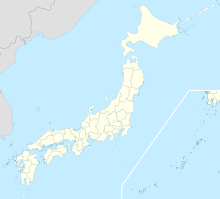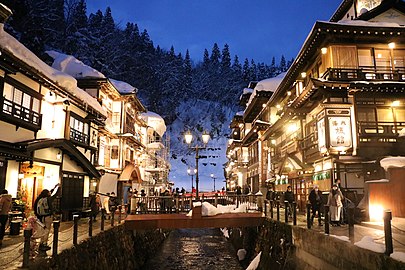| Ginzan Onsen | |
|---|---|
| Silver Mine Hot Springs | |
 | |
| Coordinates | 38°34′11″N 140°31′52″E / 38.56972°N 140.53111°E / 38.56972; 140.53111 |
| Elevation | 399m / 1,309 feet |
| Type | geothermal, volcanic |
 | |


Ginzan Onsen (銀山温泉) is an onsen (hot spring) area in Obanazawa, Yamagata Prefecture, Japan. Its name means "silver mine hot spring". Ginzan Onsen's economy grew due to silver mining and production and eventually transitioned to tourism when it opened dozens of hot spring resorts and ryokan along the central river that runs through the town. The mountains that surround this town yield rich hot spring water that is used both in the private hotels and public baths in the city center.
The center of town is a pedestrian-only district. After nightfall, the bridges and streets are lit by gaslight. In the winter Ginzan Onsen receives heavy snow. On the far side of town a 22-foot waterfall, Shirogane-no-Taki Falls, emerges from the mountains not far from the old silver mine, Nobesawa Ginzan. Internationally, this town saw a sharp rise in foreign tourism thanks to the famous snow-covered sights in the winter. There are no modern buildings within the town, the architecture is constructed from bare timber framing and white plaster, that were built during the Taisho Era (1912-1926).
There are two secluded public bathhouses (rotenburo), one of which was designed by Kuma Kengo, and a foot bath (warashiyu). Additionally some of the local ryokan permit non-lodging guests to use their indoor hot spring baths. There is a doukutsu (cave hot spring) at one of the establishments in town.
History
The hot springs were first discovered 500 years ago by miners working in the nearby silver mines. The Onsen town was founded more than 400 years ago. When silver production waned toward the end of the 17th-century, use of the hot springs declined. Later, in the early 20th century, tourism flourished in the onsen town, and several wooden ryokan, some of them multiple-storeied, were built along the banks of the Ginzan River that flows through town.
Ginzan Onsen became nationally famous as it was featured in the popular television drama Oshin, and in the film, Spirited Away. Each year this onsen village sees hundreds of thousands of domestic Japanese visitors.
Fossils from the Miocene era have been found in the vicinity.
Design
The Japanese architect Kengo Kuma, reconfigured and redesigned a 100-year old, 10,000 square-foot onsen hotel, Fujiya, by "grafting modern elements" onto the historic structure creating a hybrid of old and new that has been called "radical and subtle." His design retained the original post-and-beam facade, adding a sliding glass entry wall, a 2-story high atrium space, larger windows and reflecting pools.
Access
Access to this town requires riding a bus or taking a short taxi ride from the JR Oishida Station on the JR Yamagata Shinkansen from Tokyo. Busses depart every other hour from Oishida Station to the town of Ginzan Onsen. Travellers can use the following train passes: Japan Rail Pass, JR East Tohoku Area Pass and JR East South Hokkaido Pass; the bus ride is not included. Alternatively, a car can be rented from various stations along the Yamagata Shinkansen line, and park just outside of town.
Water profile
The hot spring water has a sulfur spring (硫黄温泉) and sulfate spring (硫酸温泉) profiles, and has a clear appearance with a slightly salty taste. It is claimed to have balneotheraputic properties for chronic skin diseases.
Gallery
References
- ^ "Ginzan Onsen: The Authentic Thermal Village in Yamagata". Kanpai Japan.
- ^ "Ginzan Onsen: 10 Things to Do & Where to Stay in One of Japan's Most Beautiful Hot Springs Towns". LIVE Japan. 17 May 2023. Retrieved 14 December 2023.
- "Ginzan Onsen: Things to Do & Where to Stay in One of Japan's Most Beautiful Hot Springs Towns". Live Japan. Retrieved 11 March 2023.
- ^ "Ginzan Onsen". Japan Guide. Retrieved 11 March 2023.
- ^ "Ginzen Onsen". Japan Travel. Retrieved 11 March 2023.
- ^ "Ginzan Onsen Guide: Winter Snowscapes, Ryokan, And "Spirited Away" Charm". Matcha. Retrieved 11 March 2023.
- ^ "Soaking in History at Ginzan Hot Springs". Nippon: Your Doorway to Japan. 7 February 2019. Retrieved 11 March 2023.
- ^ "The Marvelous and Quaint Ginzan Onsen". Yabai. 14 June 2018. Retrieved 11 March 2023.
- Pearson, Clifford A. (September 2007). "Ginzan Onsen Fujiya:Kengo Kuma wraps a hot springs hotel, the Ginzan Onsen Fujiya, in screens as exquisitely delicate as a cricket cage". Architectural Record. 195 (9). ISSN 0003-858X. Retrieved 11 March 2023.
External links
- (in Japanese) Ginzan-Hot spring Association
This article about a location in Yamagata Prefecture is a stub. You can help Misplaced Pages by expanding it. |


